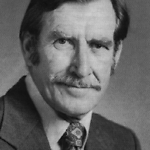Person
Wharton, Ronald Harry (1923 - 1983)
FAA

Ronald Harry Wharton
Details
- Born
- 14 April 1923
Arding, New South Wales, Australia - Died
- 18 September 1983
Mullumbimby, New South Wales, Australia - Occupation
- Zoologist and Entomologist
Summary
Harry Wharton was an entomologist with CSIRO. He worked on the systematics and biology of mosquitoes and sandflies; on the epidemiology and control of malaria and filariasis with particular emphasis on the role of mosquitoes as vectors; on the biology and control of cattle tick and on the heritability of tick resistance in cattle.
Details
Born Armidale, New South Wales, 14 April 1923. Died Mullumbimby, New South Wales, 18 September 1983. OBE 1982. Educated New England University College, Universities of Sydney (BSc (Hons) 1944, MSc 1958) and Malaya (PhD 1960). Royal Australian Air Force, Malaria Control Units 1944-45; teaching fellow, Department of Zoology, University of Sydney 1946-48; entomologist, Institute for Medical Research, Kuala Lumpur, Malaya 1948-60, senior entomologist 1960-63; Principal Research Officer in charge of cattle tick research, CSIRO Division of Entomology 1963-65, Senior Principal Research Scientist 1965-68, Chief Research Scientist 1968-77, Assistant Chief 1977-78; Officer-in-charge, Division of Entomology, Long Pocket Laboratories 1968-78; Officer-in-Charge, Centre for Animal Research and Development, Indonesia 1978-81; Division of Tropical Animal Science, CSIRO, Long Pocket Laboratories 1982-83. Chalmers Medal, Royal Society of Tropical Medicine and Hygiene 1967; Fellow, Australian Academy of Science 1973; Fellow, Australian Society for Parasitology 1981; Fellow, Australian Academy of Technological Sciences 1982. President, Entomological Society of Queensland 1966.
Related entries
Published resources
Journal Articles
- Sprent, J. F. A., 'Ronald Harry Wharton 1923-83', Historical Records of Australian Science, 6 (2) (1985), 293-301. https://doi.org/10.1071/HR9850620293. Details
Resources
- Wikidata, http://www.wikidata.org/entity/Q21537632. Details
- VIAF - Virtual International Authority File, OCLC, https://viaf.org/viaf/60700297. Details
- CA 778, Air Services Branch; CA 35, Department of Air, Central Office, 'NAA: A9300, WHARTON R H', A9300 RAAF Officers Personnel files, 1921-1948, National Archives of Australia, RecordSearch, https://recordsearch.naa.gov.au/scripts/AutoSearch.asp?O=I&Number=5402208. Details
- 'Wharton, R H (19230414-19830918)', Trove, National Library of Australia, 2009, https://nla.gov.au/nla.party-542944. Details
Resource Sections
- Sprent, J. F. A., 'Ronald Harry Wharton 1923-1983', in Australian Academy of Science Biographical Memoirs, Australian Academy of Science, 2006, https://www.science.org.au/fellowship/fellows/biographical-memoirs/ronald-harry-wharton-1923-1983. Details
- Ward, C., 'Ronald Harry Wharton', in CSIROpedia, Commonwealth Scientific and Industrial Research Organisation (CSIRO), 2011, https://csiropedia.csiro.au/Wharton-Ronald-Harry. Details
Digital resources
Rosanne Walker
Created: 20 October 1993, Last modified: 4 June 2010
- Foundation Supporter - Committee to Review Australian Studies in Tertiary Education
